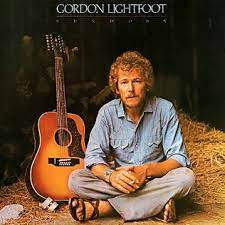Last week, we lost Canadian singer Gordon Lightfoot to Rock & Roll Heaven. In the 70s he had a series of hits which were some of the most heartfelt songs I can recall, including Sundown, If Could Read My Mind, Carefree Highway, Canadian Railroad Trilogy and of course, The Wreck of the Edmund Fitzgerald. If you were growing up in the 70s, the minute you heard the opening lines “If you could read my mind, love,/What a tale my thoughts could tell./Just like an old-time movie,/’Bout a ghost from a wishing well” and you heard the sonorous bass, you knew it was Gordon Lightfoot. According to his New York Timesobituary, “Mr. Lightfoot was a national hero, a homegrown star who stayed home even after achieving spectacular success in the United States and who catered to his Canadian fans with cross-country tours. His ballads on Canadian themes, like “Canadian Railroad Trilogy,” pulsated with a love for the nation’s rivers and forests, which he explored on ambitious canoe trips far into the hinterlands.”
For me, Lightfoot was a storyteller, creating and performing what Steve Earle called “story songs.” For me, his top story was his 1976 folk ballad about the sinking of the Great Lakes freighter the SS Edmund Fitzgerald, who sank 17 miles from the entrance to Whitefish Bay. Mike Ives, also writing in the New York Times, said “The Wreck of the Edmund Fitzgerald,” “was unusual partly because, at more than six minutes long, it was about twice as long as most pop hits. It also retold a real-life tragedy — the 1975 sinking on Lake Superior of a freighter with 29 crewmen aboard — with meticulous attention to detail.” Eric Greenberg said it was a “documentarian’s song.” It still haunts me to this day as The church bell chimed ’til it rang twenty-nine times; For each man on the Edmund Fitzgerald.
In 2019, the Business Roundtable announced the release of the Statement on the Purpose of a Corporation (The Statement). The Statement was signed by 181 Chief Executive Officers (CEOs) who committed to lead their companies for the benefit of all stakeholders – customers, employees, suppliers, communities and shareholders. It stated:
Americans deserve an economy that allows each person to succeed through hard work and creativity and to lead a life of meaning and dignity. We believe the free-market system is the best means of generating good jobs, a strong and sustainable economy, innovation, a healthy environment and economic opportunity for all.
Businesses play a vital role in the economy by creating jobs, fostering innovation and providing essential goods and services. Businesses make and sell consumer products; manufacture equipment and vehicles; support the national defense; grow and produce food; provide health care; generate and deliver energy; and offer financial, communications and other services that underpin economic growth.
While each of our individual companies serves its own corporate purpose, we share a fundamental commitment to all of our stakeholders. We commit to:
- Delivering value to our customers. We will further the tradition of American companies leading the way in meeting or exceeding customer expectations.
- Investing in our employees. This starts with compensating them fairly and providing important benefits. It also includes supporting them through training and education that help develop new skills for a rapidly changing world. We foster diversity and inclusion, dignity and respect.
- Dealing fairly and ethically with our suppliers. We are dedicated to serving as good partners to the other companies, large and small, that help us meet our missions.
- Supporting the communities in which we work. We respect the people in our communities and protect the environment by embracing sustainable practices across our businesses.
- Generating long-term value for shareholders, who provide the capital that allows companies to invest, grow and innovate. We are committed to transparency and effective engagement with shareholders.
Each of our stakeholders is essential. We commit to deliver value to all of them, for the future success of our companies, our communities and our country.
This Statement dramatically changed the conversation in the compliance and business communities and the wider US political debate. The Statement will gave every compliance officer, Corporate Social Responsibility (CSR) professional, ethicist and all others interested in moving the ball of corporations treating a variety of stakeholders with dignity and respect greater ammunition in fighting corporate malfeasance. It also presaged the explosive growth in ESG.
Many compliance professionals have struggled with how to implement a ‘stakeholder’ strategy which might focus on all stakeholders listed in the Statement. I was therefore intrigued by a recent article in the Harvard Business Review, entitled “How to Create a Stakeholder Strategy” which proposes a data-driven approach to design, measurement, and implementation by authors Darrell Rigby, Zach First, and Dunigan O’Keeffe.
In their article, the authors the interconnected relationship between all stakeholders, stating “that every stakeholder has an impact on other stakeholders—engaged employees improve customer satisfaction, which in turn spurs growth, and so on—many CEOs are pledging to generate benefits for all their constituents: customers, workers, suppliers, communities, and investors. But few leaders have explicit strategies for doing so; most seem to rely on intuitive approaches.” The authors’ approach is to use a data driven approach, noting that companies should “bolster data from such third parties with inside insights and gain an understanding of the interdependencies among their particular stakeholders.” From there move forward to developing “a clear description of their purpose, establish criteria for evaluating progress toward it, set priorities among stakeholders, and start measuring value creation for each group. The last step is sustaining the new strategy through cultural change and by developing supporting processes and organizational structures.”
Over the next series of blog posts, I will be exploring the authors ideas from the compliance perspective. I will you will find this blog post series timely and useful.
Tom’s Top 5 (all from YouTube)



